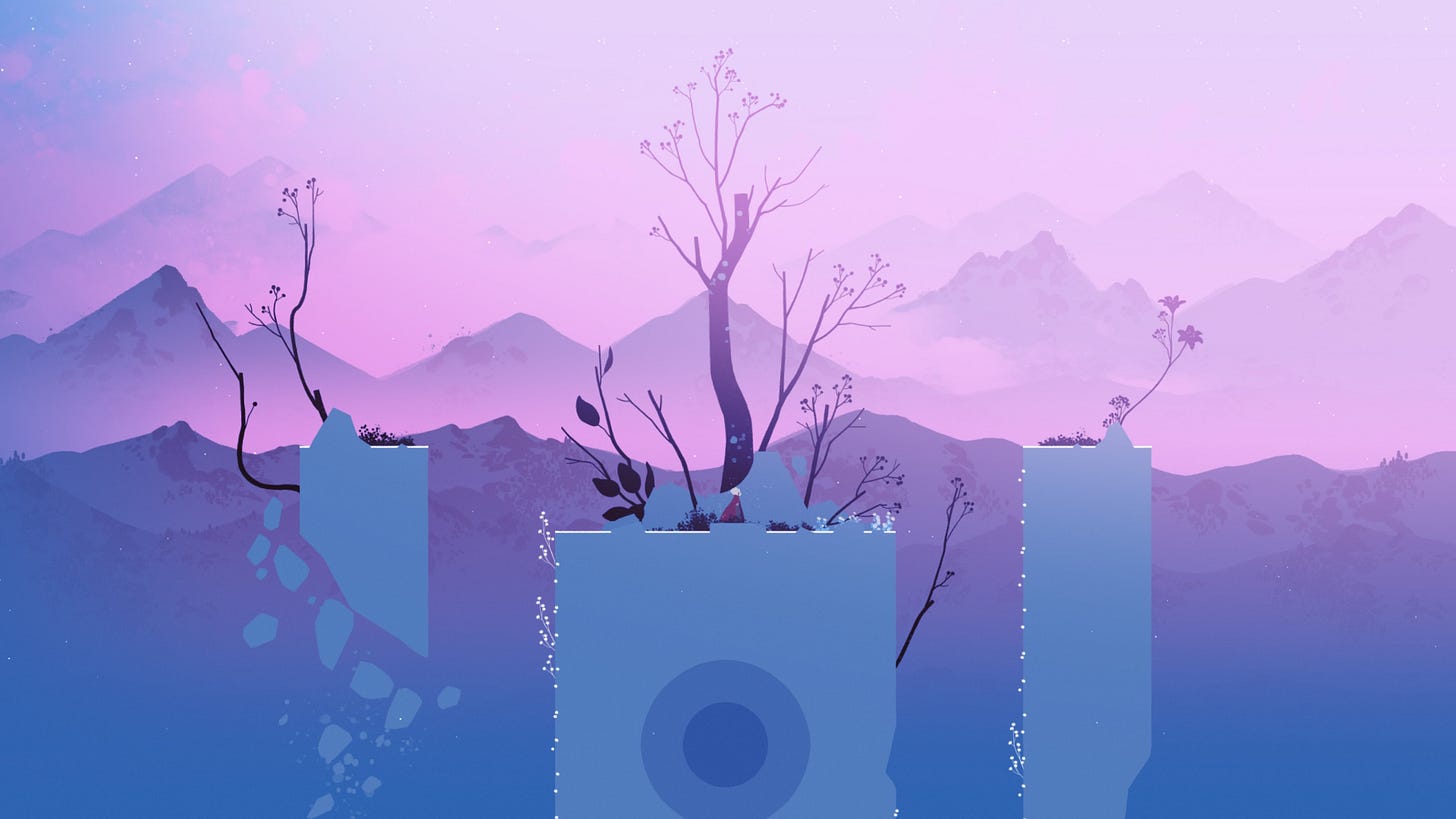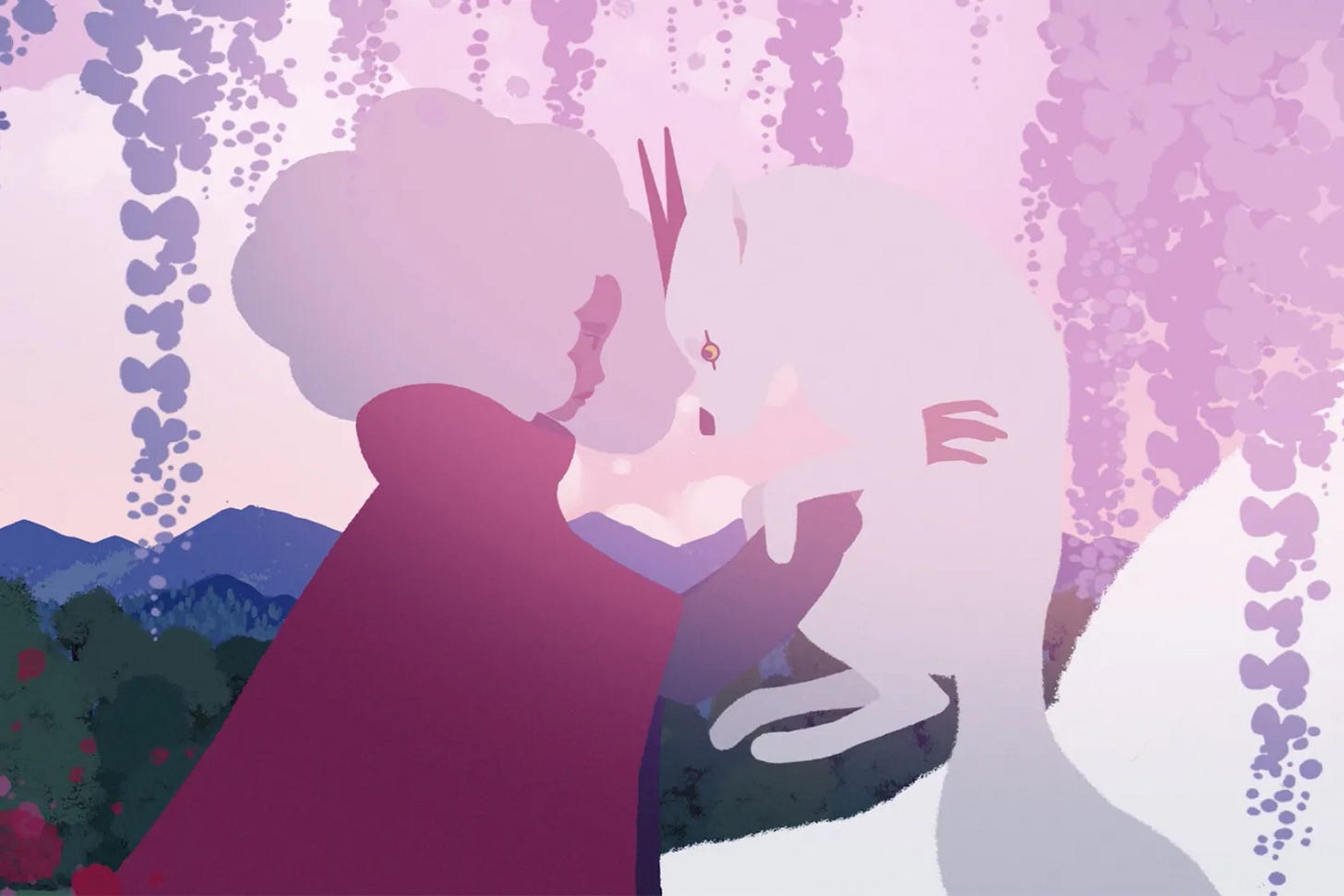This is a review that I’ve been bursting at the seams to write for nineteen months, and even still, I feel at a loss for words. I will never forget the tears streaming down my face when Nomada Studio unveiled their newest work to the world in May 2023, later evoked again in October 2024 when it adorned my PS5 home screen for the first time. Neva is more than just the game of the year in my heart. It is a towering achievement beyond belief that reinvents emotional chronology and interactive storytelling in a deeply affecting package.
Playable on all platforms including Mac, Neva is the journey that Alba and her titular wolf cub share through tender love and bitter grief from summer, to fall, to winter, and to spring.
I don’t usually do this because it’s far better to hear a song live in the world of the game itself, but this is what plays over the main menu. Before we get any further, I invite you to press play, close your eyes, and feel.
There isn’t much I can say that Berlinist didn’t already sew into the tapestry of their score. But I’ll sure try.
An almost wordless story, Neva is driven by jaw-dropping hand-painted art. Studio co-founder and lead artist Conrad Roset draws on impressionism for the densest and most intimate environments, with hundreds upon hundreds of brush strokes forming the suggestion of flora/fauna as Alba and Neva run through wooded areas graced by cascading komorebi all around them. For the bigger open vistas, he implements simpler geometry with vibrant colors that are chosen to convey temperature, tone, time of day, and level of danger in every scene. All of these factors are blended meticulously to craft a mirrored emotional experience between Alba and the player.
Summer Part I, for example, begins with tranquil, lush greens and yellows to set up the player and Alba both finding their bearings in this world as they discover something new around every corner during the blissful days of Neva's early childhood. New sensations of warmth and joy are never too far from where you’re standing as Neva splashes in puddles and chases birds for the first time, then runs after her tail in a circle as if she’s unable to contain her ecstasy. Coming to a clearing to see Neva being attacked by bigger creatures sparks a passionate instinct to rush to her defense, establishing clear motivations for why combat is a part of the game. More on that later.
On the flip side, Fall Part III is set almost fully in red and black, casting a terrifying shadow over the world. The atmosphere becomes harsh, threatening, and suspenseful as a vicious, incarnadine haze envelops the field of view. Tension incrementally builds as it gets harder to see what’s out there. Neva is the only speck of light that stands out against the stygian charcoal veil of darkness, forcing her to take the lead and protect her mother after being the one in need of protection for the whole previous act. Nightmares befall them around every turn, but Alba’s conscience is eased at least a little bit by having Neva at her side.
One of the biggest complaints that I noticed people had about Gris was that it doesn’t really feel like a game or have a ton of gameplay outside walking and jumping. Neva shuts this crowd up with significant innovations to Nomada’s platforming design as well as how they implemented combat.
The dreamlike world of this game is in a constant state of flux, decaying rapidly and scattering terrain vertically or horizontally. Allowing the player to master the climbing and air dashing mechanics quickly makes room for dozens of inspired platforming puzzles. Climbing and wall-jumping sequences work hand-in-hand with the dynamic pacing to craft scenic vistas that set Alba against stunning mountainous backdrops, or can even lend themselves to a high-stakes escape akin to those found in Ori and the Blind Forest.
The existence of combat in a Nomada game was the only thing that had me nervous about Neva’s release. I was completely content with another experience like Gris that’s made free of death or setbacks, but I was rather surprised by how much I liked it. I mentioned earlier that the story is able to intrinsically motivate combat encounters, but it’s worth bringing up again because this is not something games usually accomplish.
Combat in the majority of video games is fun extrinsically because of in-game rewards or a sense of satisfaction that doesn’t have much to do with the story. And there’s nothing inherently wrong with that, but Neva made me feel like every step was driven by my desire to keep these characters safe and defend the bond that they’ve fostered. I felt sickened every time by the sounds made when Alba is defeated by monsters not just because it’s so jarringly performed, but because it meant I had left Neva afraid and alone. I was distraught that I had abandoned Neva due to my failure in battle, and even though I knew the game would reload in a moment’s time and give me another chance, I’ve never been made emotional simply by dying like that.
Like Gris, the story of Neva highlights the nonlinearity of emotions. Our lives can change in an instant, and the road back to where we started will always lead somewhere completely new. Alba and Neva chronicle the evolving relationship of parent and child from the first embrace to the final lovelorn gaze.
Togetherness is a theme that presents itself in new ways with every passing chapter. Alba is there for so many of her child’s firsts— her first leaps and bounds, her first run through a grassy field, her first triumph over a monster— and in turn, the player engages in this togetherness as well. The player gets to take part in the joy of these moments, but is also there to soothe Neva when she gets upset and to stand up for her when she can’t stand up for herself. A band of enemies pinned baby Neva down in Summer Part I, and it made me feel like I had a responsibility to rescue her. Roset’s masterful direction led to a moment in which it seemed as though Neva needed me just as much as she needed Alba. After the encounter concluded and Neva was back on her feet, I was amazed by the innate attachment I had formed for these characters in less than half an hour of gameplay.
Such intimacy is even present in the game’s artistic discussion of grief. Defeating enemies does not leave them slain on the ground; rather, their bodies are returned to the planet and their final form before disintegrating is a multitude of scattered green flecks. Like leaves drifting off to another world. One of the hidden achievements I got while trophy hunting was to honor six fallen animals, and so after the duo would join together in a somber prayer, the creature’s body would transform from a rotted corpse into a vivacious cluster of greenery and flowers. Every frame of animation and every utterance of Neva’s name by the wonderfully nuanced Cristina Peña— who delivers the word “Neva” over 200 ways, each with its own purpose and intent— goes to show how there is no end to the love we put out into the world. Even a force as absolute and as decimating as death itself cannot take that away.
Thank you so much for reading, and thank you to Nomada Studio for giving this gift to the world. I doubt this will be the last full post dedicated to Neva, because like Journey, I feel like I’ve merely scratched the surface of what there is to glean. Coming across a piece of art such as this is like a shooting star that you’d be lucky to see once in a lifetime. I sincerely hope that you play it.






Simply stunning. Your words always transform me into another world. ❤️